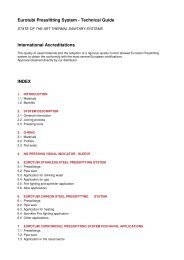Vis PDF - Damstahl
Vis PDF - Damstahl
Vis PDF - Damstahl
Create successful ePaper yourself
Turn your PDF publications into a flip-book with our unique Google optimized e-Paper software.
Technical<br />
information<br />
Chapter 2: The Alloying Elements of Stainless Steel<br />
Chromium, Cr<br />
The main alloying element in all types of stainless steel, and normally present in between 10 and<br />
25 % (by weight). The invisible passive film of the steel mainly consists of chromium oxides, and in<br />
general, the corrosion resistance in most types of media (in particular towards pitting and crevice<br />
corrosion) increases with increasing Cr content. The formation of the passive layer is at its best<br />
during aerobic (oxygenated) conditions. Ferrite stabilizing element, and mechanically, the yield<br />
strength increases with increasing Cr, and so does the heat resistance and the resistance towards<br />
high-temperature scaling.<br />
Molybdenum, Mo<br />
Added to the steel from 0.8 to 6.2 %. Even better than Cr in order to form a protective passive layer<br />
and even small amounts of Mo improve the corrosion resistance significantly, in particular in acid,<br />
anaerobic environments. Works positively against all types of corrosion. Like Cr, Mo is a ferrite stabilizing<br />
element which increases the mechanical strength of the steel.<br />
Nickel, Ni<br />
In austenitic steel types present from 8 to 25 %, in duplex 4-7 %, and less than 2 % in ferritic and<br />
martensitic types. Ni stabilizes the ductile austenitic phase and thereby works as “softener”, greatly<br />
enhancing the elongation of the steel, in particular at low temperatures. In austenites, increased<br />
amounts of Cr and Mo are normally compensated by a similar increase in Ni – just to keep the<br />
steel austenitic. Ni increases the resistance towards general corrosion and stress corrosion cracking<br />
(SCC), and slows down the corrosion velocity once the pitting or crevice corrosion has been initiated.<br />
Expensive metal with the nasty habit of creating fluctuating alloy surcharge.<br />
Carbon, C<br />
Harmful element which, apart from the martensites, should be kept as low as possible. Normal<br />
limits are < 0.08 % or 0.07 for most types; < 0.03 % for low carbon types. For martensites, C is usually<br />
kept in the range of 0.12-1.2 %; the higher C, the harder the steel after hardening. During heat<br />
treatment at temperatures in between 500 and 850 ºC (i.e. welding), C binds Cr (= sensitization)<br />
which may lead to intergranular corrosion. This is the main reason why most steel types are made<br />
as low-carbon (such as EN 1.4306, 4307, 4404 and 4435). C is a very strong austenite stabilizer, and<br />
low content of carbon must be compensated by an increase in Ni in order to keep the austenite<br />
structure. This is particularly evident in the case of 4435.<br />
Nitrogen, N<br />
Present up to 0.5 %. Useful element which enhances the passivity reaction, even in very small<br />
amounts. In practice, however, it is very hard to add N to the molten metal. Frequently used in<br />
high-end austenites and duplex steel types. N is the only austenite stabilizer which increases the<br />
Pitting Resistance Equivalent (PREN) of the steel (factor 16).<br />
285<br />
www.damstahl.com<br />
01.2013
















